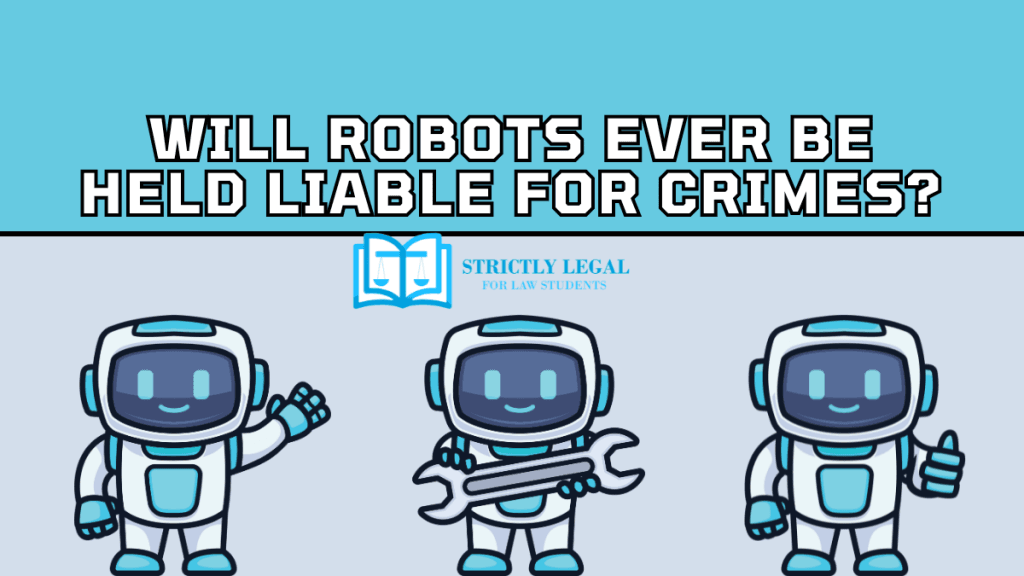The rapid advancement of artificial intelligence (AI) is transforming industries, economies, and societies in profound ways. From self-driving cars to AI-powered chatbots and facial recognition technology, machines are becoming more autonomous and integrated into our daily lives. But as AI becomes increasingly capable of performing tasks traditionally handled by humans, it raises an important question: Will robots ever be held liable for crimes? While the notion of a robot facing criminal charges may seem like science fiction, the legal implications of AI are very real. As AI systems become more sophisticated, they’re capable of making decisions that have significant consequences—some of which could be criminal. In this article, we will explore the legal challenges surrounding AI, the question of liability, and the potential for robots to be held accountable for their actions in the future.
Table of Contents
The Rise of Autonomous Machines
Autonomous AI systems are those that can operate independently without direct human intervention. Examples include self-driving cars, drones, AI medical diagnostic tools, and even military robots. As these technologies become more prevalent, they bring about new challenges in terms of accountability and responsibility. For instance, consider a self-driving car involved in an accident. If the AI system makes a decision that leads to injury or death, who is to blame? The manufacturer? The software developer? Or the AI itself?
Currently, the law operates on the assumption that humans are responsible for the actions of machines. In the case of self-driving cars, for example, the human operator, the company that developed the technology, or the owner of the vehicle may be held liable. However, as AI continues to evolve, this traditional framework may no longer be sufficient.
AI and Criminal Liability: Who Is Responsible?
When it comes to criminal liability, the issue of AI accountability becomes even more complex. Criminal law is built around the idea of personal responsibility—individuals can be held responsible for actions that are intentionally or recklessly harmful. But how does this apply to a machine that has no intent, consciousness, or understanding of right and wrong?
The question becomes: Can an AI system be considered “criminally responsible”? The short answer, under current legal frameworks, is no. The concept of criminal liability requires that the individual (or entity) committing the crime have the mens rea—a guilty mind or intent to commit the crime. Since AI systems do not possess consciousness or intent, it seems unlikely that they could be held criminally responsible in the same way a human can. However, this does not mean that AI cannot be involved in the legal process. Instead, liability would likely fall on the parties responsible for the development, deployment, and use of AI systems.
The Manufacturer or Developer
The most straightforward approach would be to hold the creators and developers of AI systems accountable. If a robot or AI system causes harm or engages in criminal activity, the company that designed, built, or deployed it could face criminal or civil liability. In the case of self-driving cars, for example, if a malfunction in the car’s AI leads to a fatal accident, the manufacturer could be held responsible for failing to properly design or test the AI. Similarly, if an AI system is used for illegal surveillance or data breaches, the company that built or deployed the system could be held liable for violations of privacy or data protection laws.
The Operator or User
In some cases, the operator or user of an AI system might be held responsible for how the AI is used. For instance, if a person uses AI to commit fraud or other illegal activities, they could be held accountable for the crime, even though the AI played a role in executing the actions. This is similar to how humans are held accountable for using tools to commit crimes. Consider a scenario where an AI-driven drone is used to illegally transport drugs across borders. The individual operating the drone may be charged with drug trafficking or related offenses, even though the drone itself performed the illegal action. The use of AI as a tool in a criminal act would still lead to human responsibility.
The Employer or Company
In cases where AI systems are deployed within a corporate environment, the employer or company could be held liable for illegal actions taken by an AI system. For example, if an AI system is responsible for discriminatory hiring practices, the company could be found in violation of anti-discrimination laws, even though the decision-making process was automated. In the workplace, the company or organization using AI tools would bear the responsibility for ensuring that the technology adheres to legal and ethical standards. Failure to do so could result in penalties, fines, or civil liability.
AI was created by Humans
Another way to describe it would be any kind of artificial creature that has the ability to use its functional capacity to carry out cognitive tasks like logical deduction and abstract reasoning, as well as independently learn new information. This organism would also be able to create long-term plans for the future by using these cognitive abilities. In actuality, this word won’t adequately describe AI until we reach a stage where the systems we create possess true intelligence. The majority of algorithms in current AI are only able to function autonomously in a very small domain, which significantly reduces their usefulness. Over the past ten years, artificial intelligence platforms have gained enormous traction in our very inventive society, with highly technical and complex technology being employed to create clever, creative, and intellectual AI systems. Therefore, it won’t be long until these clever bots start producing astounding and practical ideas without the aid of human brains.
AI and Legal Liabilities
The law can be used to determine our legal rights and obligations. Complying with the law means fulfilling obligations and reaping rewards. Therefore, the question of whether AI should have legal rights and obligations is brought up by the legal idea of AI. Even if the solution could sound forward-thinking and sophisticated, a careful analysis should take into account AI’s legal personality since doing so would make AI accountable for its deeds.
Criminal Liability
Legal personhood for AI will be required for criminal accountability, and it will be comparable to the criminal liability for businesses recognized by certain legal systems. It is believed that corporate criminal responsibility is a fictitious concept that holds the firm accountable for the conduct of its employees. AI would be held accountable for its own activities instead than being held accountable for the conduct of others, in contrast to corporations. It calls for a more careful investigation even if it seems like a simple solution that complies with the law.
Difference of approach in Criminal Laws: Why?
Any individual who commits a crime against another person would surely be subject to the criminal laws that have been put in place in that nation. Therefore, any crime committed against humanity by artificial intelligence may not be considered a traditional crime, even if it was carried out with the assistance of a robot or software that doesn’t belong to the person who made the machine, software, or program.
As a result, in order to determine the criminal liability of crimes committed by artificial intelligence, we must first determine whether AI is a legal entity in and of itself. We also need to determine the main challenges in determining the actus reus and mens rea, or the act and mental (intention) factors, respectively.
Is the Indian Penal Code relevant?
An act helped and an act committed have different repercussions, according to the principle of expected outcome established by Section 111 of the Indian Penal Code (IPC) under Chapter V of the act. The abettor will be held accountable for the offender’s activity in a manner that is nearly identical to that of if he had supported it, with the exception of a likely abetment consequence. There can be no punishment for abetment unless an act is undertaken, according to the general opinion on the subject. However, in other situations, if the evidence is sufficient to condemn the abettor but insufficient to prosecute the perpetrator, the abettor is likely to be found guilty based on the evidence and the perpetrator may be acquitted.
AI and Civil Liability
Legal actions typically accuse people of negligence rather than criminal guilt when software is defective or causes harm to a person. In the majority of cases involving carelessness, Gerstner discusses the three elements that need to be demonstrated:
- The defendant owed a duty of care to the plaintiff.
- The defendant failed to fulfill that obligation.
- The plaintiff was harmed as a result of the breach.
AI and Information Technology Act, 2000
The IPC’s concept of probable cause responsibility or abetment is sufficient to determine the offense and the punishment for those who aid and abet. To keep up with the pace of technological innovation, the Information Technology (Amendment) Act, 2008, expanded the definition of abetment to encompass acts or omissions through the use of encryption or any other electronic approach. The computer and related terminology like software are described in the Information Technology Act of 2000 (henceforth referred to as the IT Act), which aims to regulate every aspect of contemporary technology. The IT Act does not, however, address the Internet of Things, data analytics, or artificial intelligence (AI), nor does it address the potential liabilities that individuals may incur when utilizing these IT systems (particularly AI software). Considering that the main objective of the Act was to provide electronic documents and digital signatures a legal status; the Indian legislature did not give much thought to the extent of accountability resulting from AI acts and countermeasures.
Conclusion
AI technology is advancing at a rapid pace, and as it becomes more autonomous, the question of liability in cases where AI systems cause harm will become increasingly important. While robots may not face criminal charges in the traditional sense, the human entities behind the creation and deployment of AI will be held accountable for their actions. As we continue to integrate AI into our lives, we must carefully consider how to ensure accountability, fairness, and ethical behavior in the machines that increasingly influence our world. The road to determining AI liability is still in its early stages, but it is an issue that will undoubtedly shape the future of law and technology.

Law student.
Turning legal insights into engaging narratives.





